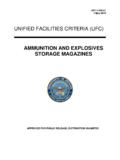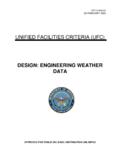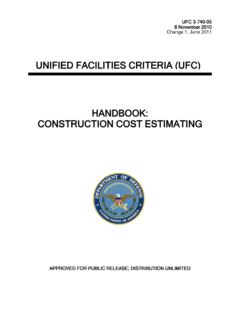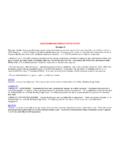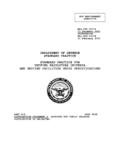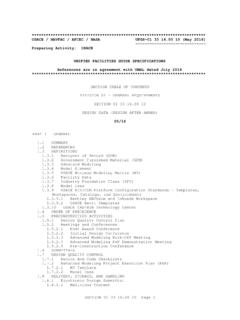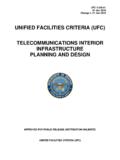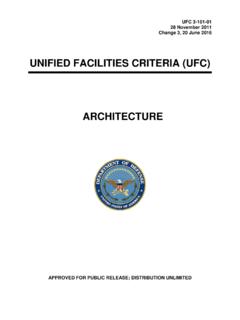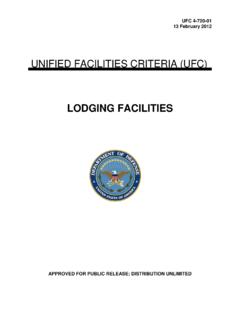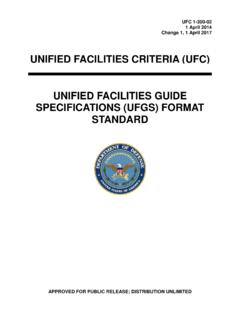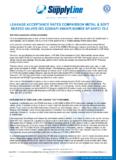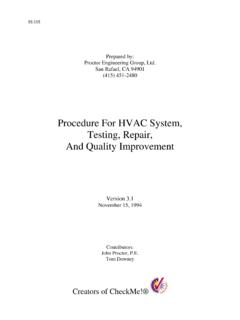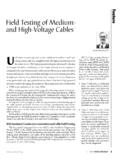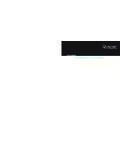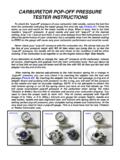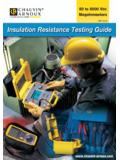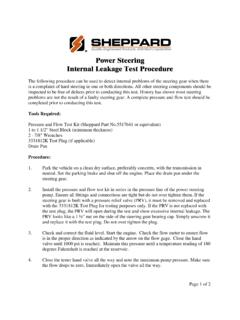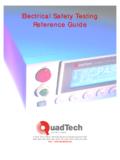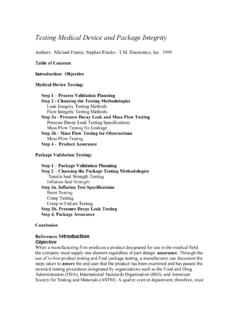Transcription of U.S.$Army$Corps$of$Engineers$ …
1 army corps of Engineers Air leakage Test protocol for building Envelopes Version 3 - May 11, 2012 Approved for public release; distribution is unlimited. USACE Air leakage Test protocol for building Envelopes Version 3: 2012- 05- 11 army corps of Engineers Air leakage Test protocol for building Envelopes Version 3 May 11, 2012 Alexander Zhivov, David Bailey and Dale Herron Construction Engineering Research Laboratory (CERL) army engineer Research and Development Center 2902 Newmark Drive Champaign, IL 61822 Contributors to this document: Len Anastasi Exo- Tec Consulting Wagdy Anis Wiss, Janney, Elstner Associates Jim Bochat Commissioning Concepts Paul Beavers Systems building envelope Consultants Terry Brennan Camroden Associates Jordan Church Exova Francis Conlin Southern Energy Management Gord Cooke building Knowledge Jeff Crow Pie Consulting and Engineering Laverne Dalgleish building Professionals Donald Dittus army corps of Engineers Protective Design Center Chris Doyle Institute for building Technology and Safety Lee Durston Brown Connally Rowan Brian Erickson Pie Consulting and Engineering Graham Finch RDH Group Colin Genge Retrotec Stan Harbuck A Better School of building Inspection Larry Harmon Air Barrier Solutions Matt
2 Heron Pie Consulting and Engineering Denali Jones Retrotec Gary Nelson The Energy Conservatory Meghan McDermott Southern Energy Management Fred McKnight Turner building Science and Design Collin Olson The Energy Conservatory Gary Proskiw Proskiw Engineering Lance Robson building envelope Technologies Kenneth Rowan Brown Connally Rowan David Saum Infiltec Colin Szewaga building Professionals Robert Thurn building Performance and Testing _____1_____ USACE Air leakage Test protocol for building Envelopes Version 3: 2012- 05- 11 CONTENTS 1 INTRODUCTION .. 2 2 USACE REQUIREMENTS FOR building AIRTIGHTNESS .. 3 building AIRTIGHTNESS REQUIREMENT.
3 3 building AIRLEAKAGE TESTING PERFORMANCE REQUIREMENT AND SUBSTANTIATION: .. 3 3 SPECIFIER AND WITNESS GUIDANCE .. 5 APPLICATION AND SCOPE .. 5 AIR leakage SPECIFICATION .. 7 Table building envelope Air leakage Requirement .. 7 ADDITIONAL INFORMATION FOR THE SPECIFIER: .. 7 4 TESTING AGENCY GUIDE .. 10 army corps OF ENGINEERS (USACE) STANDARD FOR AIR leakage .. 10 USACE PROCEDURE .. 10 APPLICATION AND SCOPE .. 10 TEST EQUIPMENT AIR FLOW CAPACITY .. 10 building envelope PRESSURE MEASUREMENT .. 12 INTERIOR PRESSURE UNIFORMITY .. 12 PRE- TEST INSPECTION AND EQUIPMENT CHECK .. 13 BEFORE STARTING THE TEST.
4 13 Record Set- up Conditions .. 13 Preparation of the building .. 13 PERFORMING THE TEST .. 14 REPORTING OF RESULTS .. 14 Table Pass/Fail Determination Chart .. 15 LOCATING leakage SITES WITH PRESSURIZATION AND DEPRESSURIZATION .. 16 ACCREDITATION OF THERMOGRAPHERS .. 17 INFRARED IMAGING SYSTEM CALIBRATION .. 17 INFRARED IMAGING SYSTEM SPECIFICATIONS .. 17 5 GLOSSARY AND ACRONYMS .. 18 GLOSSARY .. 18 ACRONYMS AND ABBREVIATIONS .. 20 A AIR leakage TEST FORM .. APPENDIX A B AIRTIGHTNESS STANDARDS .. APPENDIX B _____2_____ USACE Air leakage Test protocol for building Envelopes Version 3: 2012- 05- 11 1 Introduction On October 30, 2009 the United States army Corp of Engineers (USACE) issued a directive in Engineering and Construction Bulletin (ECB) No.
5 2009- 29 which required that all new buildings and those undergoing major renovations shall have an air leakage rate that does not exceed set values when tested in accordance with the army corps of Engineers Air leakage Test protocol for building Envelopes (test protocol ). This test protocol was originally developed by the army corps of Engineers with assistance from the private industry using ASTM E779 as a basis. ASTM E779 is not the governing document in this standard except where specific provisions of it are mentioned. On May 1, 2012, USACE issued a new Engineering and Construction Bulletin No 2012- 16 which outlines army requirements for building air tightness and building air leakage testing for new and renovation construction projects in or after Fiscal year 2012 This 2012 version 3 of this test protocol which was updated in collaboration with the Air Barrier Association of America supercedes the previous documents published in 2009 and 2011.
6 This document is intended to provide a higher level of detail than the directive to ensure that tests are conducted, and the results are reported uniformly and consistent with the directive. This document and the accompanying Test Form in appendix A (normative) both contain mandatory procedures and testing requirements. In addition to the test form in appendix A, there are accompanying sections specifically intended for Specifiers and Witness Guidance (section 3) and Testing Agency Guide (section 4). This organizational scheme, however, does not avoid the need for all test participants to read the entire document in order to be fully informed.
7 Unavoidably, there is an even higher level of detail required to conduct these tests that is beyond the scope of this document. For example, there are detailed and equipment- specific procedures to be followed for generating the air flows and measuring the air flows and pressures. This level of detail is left to the individual manufacturers of such equipment and, in some cases, to the expertise of the test agency. This is brought to the attention of the reader as appropriate. This document does not supersede the ECB 2012- 16 directive; it is intended to clarify and not alter the requirements of the directive.
8 When questions arise regarding this protocol , the reader shall seek clarification from Dr. Alexander Zhivov at Technical inquiries can be directed to the building Air Tightness Testing Standards Committee with the Air Barrier Association of America at with the subject line Question regarding USACE Air leakage Test protocol for building Envelopes . Questions will be reviewed at monthly meetings. _____3_____ USACE Air leakage Test protocol for building Envelopes Version 3: 2012- 05- 11 2 USACE Requirements for building Airtightness The following sections outline USACE requirements from ECB 2012- 16 for building airtightness and building air leakage testing for new army construction: building Airtightness Requirement The basic airtightness requirements and processes for USACE projects is the following: 1.
9 Design and construct the building envelopes of office buildings, office portions of mixed office and open space ( , company operations facilities), dining, barracks and instructional/training facilities) with a continuous air barrier to control air leakage into (or out of) the conditioned space. Clearly identify the boundary limits of the building air barriers and of the portion or portions of the building to be tested for building airtightness on the construction documents. Clearly identify all air barrier components of each envelope assembly on construction documents and detail the joints, interconnections and penetrations of the air barrier components.
10 2. Join and seal the air barrier materials of each assembly to the air barrier materials of adjacent assemblies, allowing for the relative movement of these assemblies and components. Clearly identify air barrier system continuity on the plan and section construction drawings. 3. Provide details to seal all penetrations of the air barrier assembly, including but not limited to electrical, plumbing and HVAC components; windows and doors; compatibility of materials with one another. 4. Support the air barrier so that it shall withstand the maximum positive and negative air pressures that will be placed on the building without displacement, or damage, and transfer the load to the structure.
